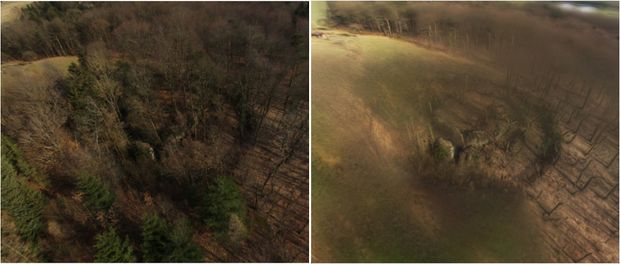Deep insight by using new Airborne Optical Sectioning (AOS) technology recently developed at the JKU's Institute of Computer Graphics.

Extensive testing over the past few months revealed that the camera drones are able to focus sharply on a desired object while making the surrounding environment disappear. The process would not only revolutionize archeology, but could also help in the search for missing persons.
Commonly used in microscopy, optical sectioning allows for the optical dissection of small microscopic samples. By using, among other things, large lenses featuring a smaller focal width, the field depth becomes more shallow. The shallow depth of field results in a very clear view of the intended object(s). Objects outside of the focal plane become so blurred that they virtually disappear.
Using Virtual Lenses
By using lenses of up to 100 meters, JKU researchers are now applying this idea on a larger scale above densely wooded areas to make objects in concealed forested areas visible from the air. The lenses, however, are not real. Little by little, a camera drone scans the light signal that would be captured by an actual lens. A computer then assembles the light to create a three-dimensional image. In the final image, the forest area disappears, revealing the hidden object(s).
Successful Test Locating Fortress Ruins
In cooperation with the Upper Austrian Museum, the first field trials were carried out at Dürnberg in Linz. The new technology developed in Linz was successfully used to optically expose the ruins of the Maximilian tower line, a 19th century fortress nestled under the dense forest area and undetectable to the naked eye from the air.
In February of this year, the story of a long-lost Mayan city discovered hidden in the jungles of Guatemala made global headlines. The discovery was made using an aircraft-mounted laser scanner known as LiDAR. The technology developed in Linz, however, has more benefits over LiDAR in that not only are there less costs and effort involved, there resolution is significantly higher and the surface color can be scanned.
Publication in a Renowned Journal
A feature in the renowned Journal of Imaging has now introduced the scientific community to this revolutionary surveying method. By being able to peer through forest density from the air, AOS could also be used in the fields of archeology, forestry and agriculture to potentially study tree and animal populations as well as to inspect trails and pathways, or detect insect infestations.








